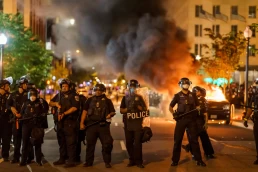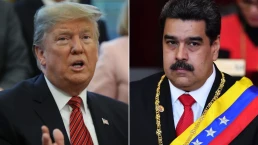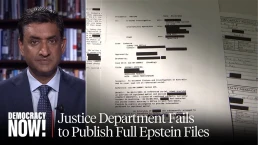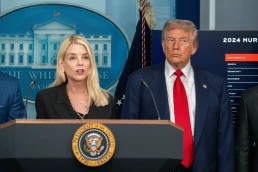As the Trump administration continues to press the boundaries of the Constitution, Johns Hopkins Professor Lester Spence says we need to understand one yet-to-be-examined source of the push towards authoritarianism: urban policing.
By Stephen Janis and Taya Graham, The Real News Network
Anyone who witnessed or was affected by Baltimore’s failed experiment with zero-tolerance policing during the aughts remembers the unrelenting chaos it created. As reporters working for a newspaper, we witnessed the onslaught of so-called quality of life arrests as a fast-moving crisis that seemed to accelerate with each illegal charge.
The policy was driven by the idea that even the most minor infraction, like drinking a beer on a stoop, was worthy of detainment in the pursuit of stopping more violent crimes. However, it soon spiraled out of control to roughly 100,000 arrests per year between 2000 and 2006. It led to bizarre examples of over-policing, like Gerard Mungo, the seven-year-old boy arrested for sitting on an electric dirt bike, or the incarceration of attendees of an entire cookout over a noise complaint.

But aside from the individual horror stories of people who ended up in jail without committing a crime, there was something else just as shocking: all of the suffering occurred in a blue city, with little if any political opposition or pushback from the Democratic establishment.
If you’re skeptical, don’t be. Post 9-11 Democrats wanted to look tough. And they were looking for a political superstar to replace former President Bill Clinton.
Then-Mayor Martin O’Malley fit the bill. He was a rising political star who the local Democratic establishment believed would eventually ascend to the presidency. Throughout his tenure, he oversaw this policy of mass arrests, hoping the ensuing drop in crime would bolster his future candidacy. Predictably, his presidential aspirations fizzled under the weight of the 2015 uprisings after the death of Freddie Gray in police custody, and crime didn’t go down.
But the results were undeniably horrific: tens of thousands of people placed in cuffs without committing a crime. An authoritarian policy embraced by a Democratic establishment that seemed to have few qualms with allowing police to create untenable conditions within predominantly African-American neighborhoods.
During the zero tolerance heyday, prosecutors were so overwhelmed by the onslaught of detentions that they invented a previously unheard-of legal terminology to address it: ‘abated by arrest.’ It was a legal classification intended to reckon with the fact that there was no legal basis for charging thousands of people police were putting into handcuffs. In other words, the arrest was illegal; prosecutors just invented a way to make it seem less so.
Zero tolerance was, in some sections of Baltimore, worse than authoritarianism—it led to a reconfiguration of the Constitution.
The city’s Central Booking facility, constructed in the ’90s with the expectation it would process around 40,000 arrests annually, was so overwhelmed that many detainees would be given what was known as a ‘walk through,’ which entailed simply walking in and out of the facility in a long serpentine line guided by corrections personnel. This overcrowding was exacerbated by the jump-out boys, who would arrive in predominantly Black neighborhoods to lead people, whose only crime was living in an area police deemed suitable for mass illegal incarceration, into the back of vans.
The point was, and is, that zero tolerance was, in some sections of Baltimore, worse than authoritarianism—it led to a reconfiguration of the Constitution. People would be illegally detained and then disappear into the Central Booking facility for months without due process. Many victims we interviewed were often released without charging documents, unable to describe or otherwise recount the crime that had landed them in jail. Baltimore was essentially non-constitutional—a bastion of notably unlawful law enforcement.
All of this backstory is a prelude to the astonishing and terrifying argument made recently by prominent Johns Hopkins professor of Political Science and Africana Studies Lester Spence.
Spence is one of a handful of innovative political scientists who examine national politics through the prism of urban governance. He is the author of Knocking the Hustle: Against the Neoliberal Turn in Black Politics. In it he argues that cities, once bastions of progressive policymaking, have become laboratories for neoliberalism.
But Spence has taken this idea one step further by making an argument that makes the Trump administration’s current unconstitutional actions even more terrifying.
During an interview for the TRNN documentary ‘Freddie Gray: A Decade of Struggle,’ Spence linked the wildly unconstitutional policing that precipitated the uprising to the anti-democratic impulses from the Trump administration that are infiltrating the country’s institutions.
“To the extent that if you looked at a map of the country and you looked and you layered density and then voted on that map, what you’d see is the most Democratic places are the densest places, and all the rest is red,” Spence explained.
“Now, if you layer onto those values about democracy, should everybody be able to get a right to vote? Should people accept the results of elections? But then, should people have a right to healthcare? Should people have a right to solid education? Should people have a right to a living wage? All those attitudes are concentrated in metropolitan areas. If you constrain the ability of those spaces to articulate those values and policy, then you constrain the ability to state on one hand… and then the nation-state on the other to actually fight for those values,” he said.
“So the sort of authoritarianism comes out of the policing and the lack of opportunity and the dysfunction of democracy.”
There are obvious connections that Spence is making here. Illegal arrests have been proven to diminish political participation. Specious criminal charges literally erode the type of citizenship that a democracy depends on.
The easy-to-construct narrative that Democrats can’t and will not impose order and don’t know how to do so has simply made right-wing talking points more salient and appealing.
It estranges, isolates, and otherwise marginalizes entire swathes of a community. Affected residents subsequently cannot access public housing, student loans, or even admission to higher education. All of these factors conclusively diminish the strength and vibrancy of our citizenry, and, as Spence suggests, mute the constituency most likely to advocate for progressive policies.
But Spence’s idea has even more profound implications if you delve deeper into the history of policing in blue cities like Baltimore. To understand its true significance, just consider a less direct force undermining democracy which is precipitated by Democrats’ commitment to aggressive law enforcement.
It starts with the conservative narrative of the failed city.
The so-called failed “Dem-run city” is shorthand for broader attacks on Democratic competence. It boils broader ideas of liberal excesses into simple narratives: The chaotic blue communities are beset by criminals and immigrants. The lawlessness and moral bankruptcy of cities that have run amok. All of it espoused by Republican candidates and right-leaning news media outlets as probable cause to run Democrats out of Washington.
The Rupert Murdoch-owned New York Post published daily stories on crime and dysfunction in San Francisco. Similarly, in our own hometown, right-wing Sinclair Broadcasting has touted a ‘City in Crisis’ series that again equates crime to failed Democratic policies and the mayhem they supposedly engender. All of this, manufactured or true, creates a perception that Democrats are wildly incompetent.
That perception gains traction, according to Spence’s idea, because—in some cases—it’s accurate.
That’s because cities under Democratic administrations have invested billions in the ostensibly flawed idea that policing was a key to reducing crime. Just like with zero tolerance in Baltimore, many Democratic mayors and elected officials not just allowed but touted aggressive and illegal policing as a proficient means to an end.
That commitment to a flawed policy has not only led to failure, but has given Republicans plenty of fodder to justify the Trump administration’s authoritarian rule. The easy-to-construct narrative that Democrats can’t and will not impose order and don’t know how to do so has simply made right-wing talking points more salient and appealing.
Baltimore’s recent drop in homicides suggests that all this spending overlooked what appears to be the most effective solution: investment in community-based programs.
The irony is, as Spence points out, that blue cities like Baltimore invested massive sums in policing for decades with meager results. Defunding the police has hardly been the problem. Here in Baltimore, for example, public safety spending has outpaced education spending for decades.
Nevertheless, Baltimore’s recent drop in homicides suggests that all this spending overlooked what appears to be the most effective solution: investment in community-based programs.
Dayvon Love, public policy director for the Baltimore-based think tank Leaders of Beautiful Struggle, made this point in the same documentary. The Baltimore Police Department, he noted, has been grappling with a historic number of vacancies, fluctuating somewhere between 500 and 1,000 officers. However, even with fewer officers to patrol the streets, violent crime and homicides have dropped significantly. In 2024 homicides dropped to 201, a 20% decrease from the year prior. This year, nonfatal shootings and homicides have continued to fall another 20% to a record low.
Some have attributed this to a broader national trend towards lower homicide rates. But, as Mayor Brandon Scott recently pointed out, Baltimore has always bucked fluctuations in homicides and violent crime.
Instead, Scott attributes the drop to the city’s commitment to community-based programs like the Gun Violence Reduction Strategy, which uses a coordinated community-based approach to persuade high-risk residents to get a job rather than commit a crime. The city, with the help of the state of Maryland, has also made historic investments in Safe Streets, a violence interruption program in which former felons mediate disputes before they turn violent.
All of this points to the fact that Democrats’ past use of aggressive policing has been a boon for Republicans because it was not just the wrong solution, but a prescription for electoral failure as well. Whether or not the Republican depiction of this policy has been fair, the fact remains that Democrats across the country have invested countless billions into authoritarian policing with little impact on crime, and as a result have paved the way for an authoritarian national movement.
If these two trends continue, as Spence suggested is possible, then we are in big trouble.
Just consider the findings of the Justice Department report that was released after its 2016 investigation into the Baltimore Police Department in the wake of the death of Freddie Gray in police custody. It found that, among other abuses, police arrested one man 44 times. It also revealed that several extremely poor and mostly African-American neighborhoods were targeted with mass arrests to the point that a person could be detained for simply walking in an area where they did not live.
If that sounds scary, consider the fact that the editor of the paper I worked for was arrested after we published the overtime earnings of all the officers on the force during the zero-tolerance era. Police contrived a crime to effectuate the arrest, accusing him of pointing a shotgun at his neighbors. The case fell apart after his lawyers pointed out that all of this occurred in the privacy of his home and that the aggrieved neighbor had only witnessed the infraction through a shut window. However, that did not stop a cadre of heavily armed officers from dragging him into the same Central Booking facility as the other victims of the city’s mass arrest movement.
Even more troubling were the sheer numbers of arrests effectuated by a relatively small number of officers. At its peak, BPD had roughly 3,000 sworn cops—and the number of people they managed to arrest was thousands of times greater. Imagine if the vast federal bureaucracy embarked on a similar program of nationwide detentions.
That program is, actually, already happening. The Trump administration has enlisted the FBI and IRS to help arrest immigrants, a task usually outtside their respective purviews.
The point is, we have witnessed how over-policing changes the contours of government, and if this same mentality pervades the federal institutions and agencies, it will be more terrifying than it’s already been.
Spence’s insight should be heeded as not just a cautionary tale, but a call to action. Baltimore has made positive changes to commit resources towards a community based approach to crime intervention. The question is, will it be enough?
Stephen Janis is an award winning investigative reporter turned documentary filmmaker. His first feature film, The Friendliest Town was distributed by Gravitas Ventures and won an award of distinction from The Impact Doc Film Festival, and a humanitarian award from The Indie Film Fest. He is the co-host and creator of The Police Accountability Report on The Real News Network, which has received more than 10,000,000 views on YouTube. His work as a reporter has been featured on a variety of national shows including the Netflix reboot of Unsolved Mysteries, Dead of Night on Investigation Discovery Channel, Relentless on NBC, and Sins of the City on TV One.
Taya Graham is an award-winning investigative reporter who has covered U.S. politics, local government, and the criminal justice system. She is the host of TRNN’s “Police Accountability Report,” and producer and co-creator of the award-winning podcast “Truth and Reconciliation” on Baltimore’s NPR affiliate WYPR. She has written extensively for a variety of publications including the Afro American Newspaper, the oldest black-owned publication in the country, and was a frequent contributor to Morgan State Radio at a historic HBCU. She has also produced two documentaries, including the feature-length film “The Friendliest Town.” Although her reporting focuses on the criminal justice system and government accountability, she has provided on the ground coverage of presidential primaries and elections as well as local and state campaigns. Follow her on Twitter.
Recent Posts
The “President Of Peace” Prepares For War
December 23, 2025
Take Action Now The Donroe Doctrine Hits HomeBy William D. Hartung, Tom Dispatch Earlier this month, the Trump administration released its new…
“Who Are They Protecting?”: Rep. Ro Khanna Urges Contempt Charges Over AG Bondi’s Epstein Redactions
December 22, 2025
Take Action Now “The House can act unilaterally on contempt, and this will be introduced by Thomas Massie. What the resolution will say is that…
Dems Demand Answers as Trump Photo Disappears From DOJ Online Epstein Files
December 21, 2025
Take Action Now “What else is being covered up?”By Brett Wilkins, Common Dreams Congressional Democrats on Saturday pressed US Attorney General…
Elon Musk Is Vowing Utopia Driven by AI and Robotics. Bernie Sanders Has a Few Questions
December 20, 2025
Take Action Now “I look forward to hearing about how you and your other oligarch friends are going to provide working people with a magnificent life…




